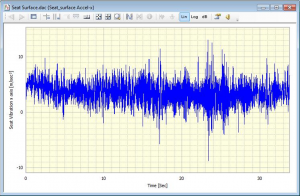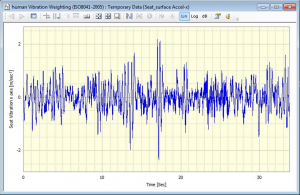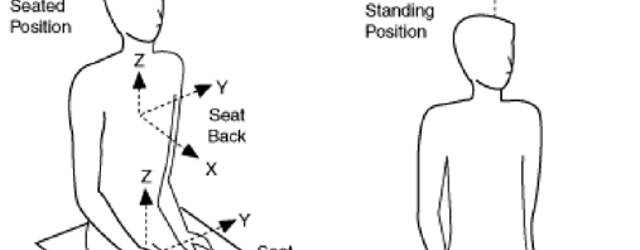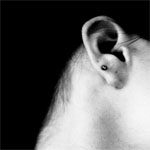Various human body vibration measurements and assessments are defined in the ISO2631, ISO5349, ISO6954 standards and also in the EEC vibration directive 2002/44/EC. These assessments are based on the analysis of acceleration data that has been weighted (filtered) with appropriate vibration weighting values. The data must be in units of m/sec2.
The vibration weighting values are defined in ISO8041:2005. Basically they are a set of filters that must be applied to the acceleration data in order to make evaluations and assessments on the effects of vibration on humans. They are defined as a set of weighting classes. Each class is associated with particular measurement directions, measurement positions and assessment type.
A selection of defined weighting classes are shown in Table 1. The directions are orientated such that the x direction is positive back to chest, the y direction is positive right side to left side and the z direction is positive from feet to head.
| Weight Class | Description |
| Wb | Weighting for vertical whole body vibration (seat z direction): ISO2631-4 |
| Wc | Weighting for vertical whole body vibration (seat back z direction): ISO2631-4 |
| Wd | Weighting for horizontal whole body vibration (seat surface x and y directions): ISO2631-1 |
| We | Weighting for rotational whole body vibration: ISO2631-1 |
| Wf | Weighting for vertical whole body vibration (z direction motion sickness): ISO2631-1 |
| Wh | Weighting for hand arm vibration (all directions): ISO5349-1 |
| Wk | Weighting for vertical whole body vibration (z direction): ISO2631-1 |
| Wj | Weighting for vertical head vibration (x direction recumbent ): ISO2631-1 |
| Wm | Weighting for whole body vibration in buildings (all directions): ISO2631-2 and ship vibration measurements (all directions): ISO6954 |
Table 1
The vibration weighting is applied by initially pre-filtering the data with a band pass filter between a lower frequency, f1 and an upper frequency, f2 as defined in Table 2. The appropriate weighting functions are then applied to the resulting band filtered data.
| Vibration Weight Class | Lower Frequency f1 Hz | Upper Frequency f2 Hz | ISO8041 Compliant Minimum Sample Rate (Samples/sec) |
| Wb | 0.4 | 100 | 900 |
| Wc | 0.4 | 100 | 900 |
| Wd | 0.4 | 100 | 900 |
| We | 0.4 | 100 | 900 |
| Wh | 6.3 | 1259 | 11331 |
| Wf | 0.08 | 0.63 | 6 |
| Wj | 0.4 | 100 | 900 |
| Wk | 0.4 | 100 | 900 |
| Wm | 0.79 | 100 | 900 |
Table 2
Strict ISO8041 Compliance
ISO8041:2005 specifies that the acceleration data must be sampled at an adequate rate for the appropriate vibration weight class filter to be applied. In order to achieve strict ISO8041:2005 compliance the minimum adequate sample rate must be at least nine times the relevant low pass pre-filter cut off frequency, f2. As shown in Table 2 the minimum ISO8041 compliant sample rate is 900 samples/second (9*f2 = 9*100) for all vibration weight classes with the exception of class Wf where it is 6 samples/second (9*0.63) and class Wh where it is 11331 samples/second (9*1259).
The DATS software provides a particular function to perform the vibration weighting for a specified vibration weight class. In addition, DATS also provides a package to generate vibration assessment reports compliant with ISO2631-1, ISO2631-2, ISO2631-4, ISO5349 and ISO6954.
An example seat surface acceleration is shown below in Figures 1 and 2. Figure 1 shows the raw acceleration data and Figure 2 shows the acceleration after the appropriate ISO8041 compliant vibration weighting has been applied. In this example the data is seat surface data in the X direction so the appropriate vibration weight class is the Wd filter.


Dr Mike Donegan
Latest posts by Dr Mike Donegan (see all)
- How Do I Measure Whole Body Vibration? - March 20, 2015
- Sampling and Filtering Data for ISO8041 Compliance and Human Body Vibration Data Weighting - July 10, 2014
- What is Auto Spectral Density? - March 12, 2014






Its interesting that an AC coupled device is used limiting the lower frequency threshold. DC device would allow 0Hz response and gravity referenced data which is more representative of whole body vibration. Do you think that this is a compromise?
Gravity is always ‘on’ and as such it should not cause any vibration